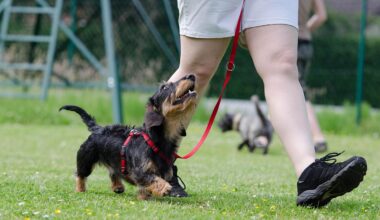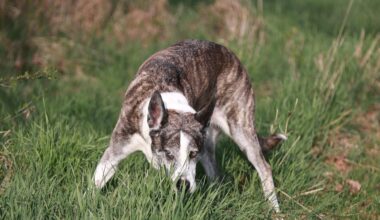How to Interview Dog Adopters About Training and Exercise Plans
When considering dog adopters, it’s essential to assess their knowledge and commitment to training and exercise. Ask simple yet insightful questions that help gauge their understanding of canine behavior and needs. For instance, inquire about their previous experience with dogs and what training methods they plan to employ. This will provide insight into their preparedness for the responsibilities of dog ownership. Additionally, understanding their exercise plans is equally critical. Determine how they intend to incorporate regular physical activity into their new dog’s life. This includes daily walks or play sessions, as these are vital for a dog’s health. Clearly defined routines can also significantly ease the transition for both the adopter and the dog. Moreover, it’s important to assess the adopter’s lifestyle. Ask about their daily schedule, as it directly influences how much time they can devote to training and exercising their pet. Finally, encourage honesty; potential adopters should feel comfortable discussing their intentions and limitations regarding their pet’s care.
Furthermore, consider discussing various training techniques during the interview. Highlight the importance of positive reinforcement methods, as they are generally more effective and beneficial for the dog’s emotional well-being. Be sure to ask potential adopters how they plan to handle challenges such as behavioral issues, which often arise during the adjustment phase. This can reveal their problem-solving skills and patience level, traits crucial for any dog owner. Discussing their understanding of dog behavior will also reveal their commitment to training. Additionally, integrating fun training activities could be a wonderful way for adopters to bond with their new furry friend. Exploring different training options and techniques can also showcase their commitment. Furthermore, it opens up discussions about socialization and exposing the dog to different environments. How do they plan to introduce their new pet to other animals or people? Socialization is crucial for a well-adjusted dog, so these insights can be valuable. Moreover, ask how they will maintain consistency in training, as this is essential for lasting behavior change.
The Importance of Exercise in Dog Life
Training goes hand in hand with exercise, as physical activity plays a vital role in maintaining a dog’s health. During the interview, delve into the prospective adopter’s understanding of exercise needs based on the dog’s breed, age, and temperament. It’s beneficial to explore how they envision their dog’s daily exercise routine. Each breed has unique exercise requirements, and potential adopters should acknowledge this. Discuss how they plan to meet the specific needs of the breed they wish to adopt. For example, high-energy breeds like Border Collies require substantial daily physical activity, while others may need less. Equally important, inquire about their contingency plans when they can’t exercise their dog as scheduled. This might include arranging doggy playdates or hiring a dog walker. Their responses will indicate their level of commitment and planning for their new pet’s exercise needs. Also, encourage potential adopters to engage in activities such as obedience classes or dog sports, which can enrich both the dog’s life and the bond between them.
Another aspect to address during the interview is the adopter’s long-term commitment to both training and exercise. Ownership involves dedication throughout the dog’s life, including adapting to changes in circumstances. Ask about their plans to adjust their training or exercise routines as the dog ages or faces health issues. Understanding their foresight will give a clearer picture of their sincerity in adopting. Moreover, discuss the importance of mental stimulation alongside physical exercise. Activities such as puzzle toys or training sessions keep dogs mentally sharp, improving overall behavior. Explore how potential adopters plan to prevent boredom-related obedience issues, as a bored dog often exhibits disruptive behavior. Additionally, it’s vital to ascertain how they plan to incorporate socialization into their pet’s routine. Social interactions can profoundly impact a dog’s happiness and behavior. Discuss how often they plan to visit dog parks or arrange playdates with other dogs. Engaging in these activities not only satisfies exercise needs but also helps in building a well-rounded dog that’s a joy to live with.
Final Thoughts on the Adoption Process
Ultimately, the interview process serves both the rescue and the potential adopter. It’s about finding a perfect match between the dog and the individual or family. Training and exercise discussions can reveal how prepared the adopter is for dog ownership. It’s crucial that they understand the effort required in both training and exercising the dog. Therefore, fostering open communication throughout the interview encourages honest responses. Remember, patience is vital, as some people may need more guidance than others in understanding their future responsibilities. This entire process facilitates not only a successful adoption but also educates potential dog owners on what it means to be responsible. Equipped with knowledge, adopters can confidently bring a dog into their home. The goal is to empower the adopter with the necessary information to make informed decisions. Additionally, always provide resources or referrals for training and exercise programs after the adoption. This support fosters ongoing education, helping new dog owners navigate their journey with confidence and ensuring a positive experience for both the dog and owner.
In conclusion, interviewing dog adopters is a multifaceted approach rather than a simple questionnaire. It requires engaging dialogues around training and exercise that illuminate the adopter’s readiness and commitment. Other factors, such as lifestyle, household environment, and financial readiness, also contribute to successful pet ownership. Each interview question should personally connect with the future caregiver’s ability to provide necessary training and consistent exercise for their new dog. This living creature will depend on them for love, safety, and stimulation, which underscores the gravity of the decision being made. A strong foundation built on effective training and regular physical activity contributes to a prosperous dog-owner relationship. The interview can help ensure that the right match is made, considering both the adopter’s capabilities and the dog’s needs. Ultimately, every involved party should walk away from the process feeling satisfied and optimistic about the future. By prioritizing responsible adoption practices, we can greatly enhance the quality of life for dogs and their human families. Empowering prospective dog owners through this process not only leads to happy homes but encourages responsible and loving pet ownership.
Additional Resources for Dog Adopters
For those engaged in the dog adoption process, many resources are available that offer additional support on training and exercise. Websites such as the American Kennel Club provide invaluable information on breed-specific exercise recommendations and training techniques. Furthermore, local shelters often have workshops and classes tailored to new dog owners. It’s beneficial for adopters to tap into these resources, as they foster education in a supportive environment. Pet stores frequently host training events, offering sessions on basic obedience to more advanced skills. Engaging in these community activities can create networking opportunities with fellow dog owners. These interactions can also help in sharing training tips and generating ideas on keeping dogs active and engaged. Online forums and social media groups dedicated to dog training are also beneficial platforms for sharing experiences. Ultimately, investing time in these educational resources equips adopters with the knowledge necessary to thrive in their new role. The aim is to cultivate a harmonious relationship between dogs and their owners, ensuring longevity in their companionship.


